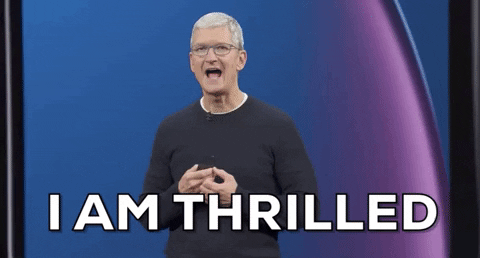The Big Apple
5 in 5 - Brave & Heart HeartBeat #158 ❤️
This week we’re doing an Apple special. Despite the fact that Tim Cook is the blandest and least charismatic most cardboard man ever to lead a tech company, making Bill Gates look like Elvis Presley and forcing us to fondly reminisce the day when Steve Black Turtleneck Jobs was at the helm, right now Apple are undeniably at the centre of a lot of the current tech and marketing trends.
From the introduction of spatial computing via their headset, to their very Apple take on the current AI hype and why their marketing very rarely misses.
Let’s get into it.
Were you forwarded this? Not a subscriber? 👉 Sign up here
#1 The Apple Vision Pro
Drumroll please…. Of course we had to start with the freshly unveiled Apple Vision Pro.
Apple announced at their most recent WWDC (Worldwide Developers Conference for the unitiatiated – the initiated treat the event as seriously as others treat The Oscars or The Olympics) the unveiling of their VR/AR headset, the Apple Vision Pro.
The technology used in the headset is undeniably incredible, so much so that one of the journalists testing it said that, knowing what’s in there, the headset more than earns it’s hefty pricetag of $3499. Obviously that last dollar really makes the difference, watch the pennies as they say...
Apple seem to have solved the problem of VR with their “video passthrough” - headset users are never in a completely different world as the headset brings what they’re doing into the real world. Notably, a journalist who mentioned the word “metaverse” during press trials of the headset was given a dressing down – this is NOT the Metaverse.
The tech they use to do this is seriously impressive. You can see your space thanks to a whopping twelve cameras around the headset, which film and project what’s outside the headset into your eyes, with your apps, video calls or internet browsing overlaid on top. Similarly, people looking at you will see a virtually created video of your actual eyes. Yeah, seriously.
FaceTime with the Vision Pro is just as nuts. The cameras in the headset scan your face and use advanced machine learning (Apple for AI) to create a photorealistic "Persona" for video calls – which moves and talks in your place. Apparently, in a future visionOS update, they’ll become more realistic, and maybe less uncanny valley-ey (or not).
We could go on and on, watch the video for yourself to see the rest – they’re not sponsoring us, we WISH – it’s just really that impressive. (The technology in itself that is, whether it’s a useful product or even a positive thing for the future of personal tech are different questions entirely).
Would we still be allowed to make fun of the turtleneck if they sponsored us, or is that out of bounds?
Apple, We’ll Take A Million Dollars For Sponsorship. Get In Touch.
#2 - Apple & The A Word
Two words were notably absent from Apple’s promotional videos for the Vision Pro, and their WWDC keynote in general – Artificial Intelligence.
Compared to Google’s keynote last month, where AI was mentioned literally 99 times in the space of two hours, Tim Cook studiously kept tech’s two biggest buzziest words out of his mouth.
The words “machine learning” were used to describe any tech which runs on AI. And that makes sense, because, basically, that’s what AI actually is. Most serious computer scientists use the phrase machine learning, as artificial intelligence doesn’t accurately describe the technology, and is overlaid with sci-fi connotations.
However, we suspect that’s not the whole reason that Apple avoided saying the magic words. On the subject of the AI scramble happening in tech right now, Mashable quite nicely described Silicon Valley as being made up of two teams. The team playing a frantic ball game, all rushing to get the ball, which in this case, is AI, and the other team, made up of pretty much just Apple.
Apple are calm and collected in their own bubble, and in a company where products are ruthlessly iterated for years, even decades, before they see the light of day, short-term trends are studiously ignored.
And while most of the new features Apple announced in their operating system and the Vision Pro run on AI – the FaceTime avatar generation, the new app Journal, even AirPod’s noise detection – the fact remains that for the moment, AI is new (even if it actually isn’t, at all). In the mind of consumers, it’s new - and for many consumers, it’s scary.
And do we really need to know the tech behind their newest offerings? In a context where everyone is becoming an expert, Apple may want to keep some of the mystery alive.
We don’t want to know how their computer chips are made, and when the AI hype dies down, we won’t want to know how our FaceTime avatars are generated either.
#3 Has VR Met It’s Match? Why Apple Marketing Might Actually Get It Off The Ground
Apple did what Meta have not been able to do – they’ve made it easy for the average consumer to see how VR will fit into their actual lives.
Perhaps learning from the mistakes made by Mr Metaverse, they didn’t try to introduce “big, weird concepts” like the aforementioned Metaverse itself, at the risk of alienating huge swathes of consumers.
Watching the promotional video, it feels like we’ve finally been given the answer to the question that’s plagued VR headsets from the very beginning – what’s the point?
While the suggestion that we need one may still be tenuous, Apple seems to have told us all why we might want one, and it’s not to watch fake concerts in Minecraft, or get virtually groped in chatrooms. The Vision Pro’s concept makes the headset feel like a natural extension of home computing.
The beautiful people in beautiful settings in the promo materials obviously help, and the sleek design (as sleek as what is essentially a pair of goggles can be) give the product an aspirational feel that has been missing up until now.
The focus on work, image and video capture, and home entertainment, takes the headset out of the gaming world – where it has been stuck for a while – and into our actual lives, in the real world. In comparison, Meta’s approach seemed to be more about taking us out of the real world and into the Metaverse – and not many of us wanted to go there.
Apple have brought the headset to us, rather than us having to do the brain work to imagine ourselves in the headset’s world.
#4 - Meta vs Apple – The Headset Wars
Is Mark Zuckerberg crying into his cornflakes right now? While the answer is probably yes, publicly he’s pointing out the differences between Meta’s view of the future of computing and Apple’s, and not coming across like a sore loser at all…
Mr Z has described it as a “lonely” vision of the future, with people sitting on their own on their sofa. Which is obviously way worse than being constantly in a Metaverse where you live your life as one of the little men from the Wii Sports games, but we digress…
The difference is that after the announcement of the Vision Pro, it’s hard to see a future of computing without a wearable headset, whereas up until now, when only Meta’s offerings were available, it was pretty easy – if not preferable.
If you watch the much-ridiculed metaverse launch video, and then watch the Apple promo video for the Vision Pro, the difference is striking.
Clara Murray at Raconteur said it best when she described the metaverse launch video as serving up “a primary-coloured cartoon office hellscape” in comparison to Apple’s video of beautiful people in beautiful homes, noting that “no one over the age of 35 or not blessed with razor-sharp cheekbones has been allowed near a Vision Pro” - Tim Cook included.
In addition, Apple seem to have corrected many of the gripes technology-wise that people have had with the Oculus headsets, although Zuckerberg stated that they haven’t come up with anything new, and haven’t presented any technology “breakthroughs” that Meta hadn’t “already considered”. A likely story…
Despite this, the launch of the Vision Pro might be a huge boost to Meta’s headsets for one main reason – they’ve made people want a VR headset.
The iPhone, the Apple watch and Airpods have probably all boosted the sales of cheaper alternatives just by existing. Apple may have created the demand, but the Vision Pro price tag is huge, so where are people going to go to get the next best thing for a fraction of the price? The Oculus headsets.
It remains to be seen if Meta will try and cash in on this by copying some of what Apple announced in their unveiling, or if Marky Mark is set on his Metaverse dream.
#5 - The Flipside
Of course, the Vision Pro’s angle and advertising message haven’t been unanimously accepted, and not just by the Z-man.
Vice magazine described it as “a $3,500 ticket to nowhere” and some people see the decision to launch only in the US as a sign that Apple themselves don’t have full faith in the product. This skepticism, rather than a marketing angle, could also be behind Tim Cook’s decision not to wear the headset himself – preferring not to be photographed wearing it in case it flops.
Many of the negative commentary centres around Apple’s insistence that you could and should be wearing the headset while interacting with your family.
One commentator notes that while we are often on our phones anyway, the headset is a whole lot more isolating. How do you share a photo you just took with the person next to you, how do you show a funny video you just saw when you watched it on the headset?
Also, how are you supposed to feel closer to those you’re FaceTiming if it’s not even your actual face they’re seeing? Sure, watching a movie that wraps around your eyes in 4k definition with an open sky in the background does sound amazing – but you’ll be doing it by yourself.
One part of the promo video deemed as “dystopian” was the dad taking a video of his kids with the headset on, and them innocently looking at him wearing ski goggles with fake video versions of his eyes on them. Why do Apple want us to be videoing our kids parties rather than taking part in them?
While this one did seem to get past the marketing team, an answer has been suggested in the form of their final goal with this technology. Once the huge goggles become a nifty little pair of VR specs, they won’t look out of place at your kids birthday party, and you’ll be able to relive the moment in high definition for years to come.
Brave & Heart over and out.
Bonus
Pessimist’s Archive
All this new technology gets you thinking, doesn't it?
Although VR headsets were introduced as a concept back in the 90s, they’re still going through a myriad of changes, each one met with not always positive reactions.
The Pessimist’s Archive is a nifty little website featuring newspaper clippings of outrage and horror at new inventions, from the telegraph to the computer.
Will we all be proved wrong one day about VR headsets, or did Apple just do it?
To find out more on how you can retain your top talent, or how we can help you with digital solutions to your business and marketing challenges, check out our case studies.



